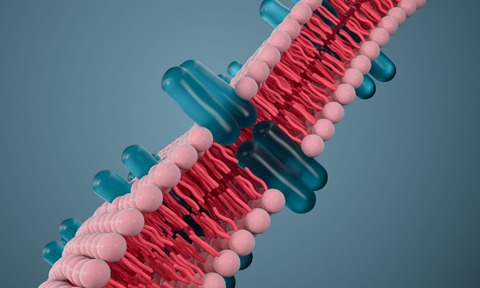
The IMPALA-NET network is developing a polymer-lipid particle technique to preserve the lipid environment of cell membrane proteins with the aim of improving drug discovery and testing for a wide range of different diseases. Project leader Alice Rothnie explains its work.
Membrane proteins are vital for life, controlling what enters and leaves cells, intracellular communication and energy generation. They are the target of c.50% of current drugs, and are of considerable interest for agriculture and healthcare. However, despite their clear importance, their location within the lipid bilayer of cells and organelles, tightly packed with many different proteins and lipids, has hampered their study.
To gain meaningful insight into the structure or function of a single protein, it needs to be extracted from the complexity of the membrane. Traditionally this was achieved using detergents which disrupt the native membrane, removing most, if not all, associated lipid, forming a micelle around the protein.
However, it is increasingly clear that membrane proteins form complexes with lipids and other proteins that influence their structure, function, dynamics and regulation.
Polymers such as styrene maleic acid (SMA) could revolutionise the study of membrane proteins. These polymers insert into native membranes and directly extract polymerlipid particles (PLPs) – nanodiscs containing membrane proteins and their surrounding lipid bilayer. Thus, PLPs offer a unique approach for isolating membrane proteins and studying their structure and function, while retaining a lipid bilayer environment.
In the past 15 years the core team members leading this network have worked on demonstrating the use of these systems for a range of different proteins and techniques. This has included applications for structural analysis, functional characterisation, lipidomics to analyse the lipids that co-purify with a protein, native PLP-PAGE to study complexes, and analysing membrane protein folding intermediates.
The maintenance of lipid environment confers much greater stability to the membrane protein. The particles are small and therefore much more amenable to spectroscopic approaches than liposomes. They are stable once formed, meaning they are technically easier to work with than detergent solubilised proteins, avoiding the need to supplement all buffers with detergent to maintain solubility. Moreover, the presence of the native lipids proffers a much more realistic binding environment when screening for drug binding.
Despite the great potential offered by PLPs, there remain several knowledge gaps that hinder exploitation of this influential technology, and there is a lack of cohesive information available for researchers wishing to start working with this approach. A key problem is that several fundamental issues are not fully understood, such as the molecular mechanism by which the polymers form the PLPs, the number of polymer chains that wrap each particle, or precisely which features of a polymer structure are key at which stage.
To gain meaningful insight into the structure or function of a single protein, it needs to be extracted from the complexity of the membrane
To achieve this, we need a community effort bringing expertise from a range of disciplines, and a forum in which to share things that haven’t worked as much as those that have. In addition, the original polymer SMA has limitations. These include a sensitivity to low pH or to divalent cations, and an interference in binding to affinity resins.
In some cases, the lipids within the particle are too ordered for full conformational changes of a protein. To try to overcome this there has been a lot of work in the last few years to modify the polymer structure. While there are new polymers that overcome some of the limitations, this has led to a secondary problem.
For anyone new wanting to give this approach a try there are now many different polymers from different suppliers to choose from – mainly reported in publications with different targets and limited comparison. This makes it very difficult to know the best way to start. Equally, the lack of knowledge on precise mechanisms has also hindered polymer design. Finally, while the PLP approach has been adopted well within academia, it is much less utilised within industry.
The vision of IMPALA-NET is to realise the transformative power of PLPs for the study and application of membrane proteins, driving forward world-leading research in therapeutic discovery, leading to long term societal impact. IMPALA-NET will create a vibrant, multidisciplinary and diverse network of researchers across the UK who will share ideas, challenges and best practice, and develop generic, robust, approaches for deploying PLPs at the frontline of medical and biotech applications.
Pump-priming and travel exchange funds will enable collaborative research projects bringing polymer technology to new membrane proteins. Our information hub will be the go-to resource for standard protocols and application notes to enable the wider research community to fully exploit the benefits of PLPs.
The network will be formally launched later this year and will be open for all researchers interested in membrane protein studies to join.
Dr Alice Rothnie is a Reader in Biochemistry at Aston University
References:
IMPALA-NET (Integral Membrane Proteins and Lipid Assemblies NETwork) recently won a Biotechnology and Biological Sciences Research Council (BBSRC) Network grant of £345,000. In addition to Aston University, its collaborating partners include King’s College London, Imperial College London, Diamond Light Source, the University of Birmingham and the University of Leeds
Pics: Shutterstock

